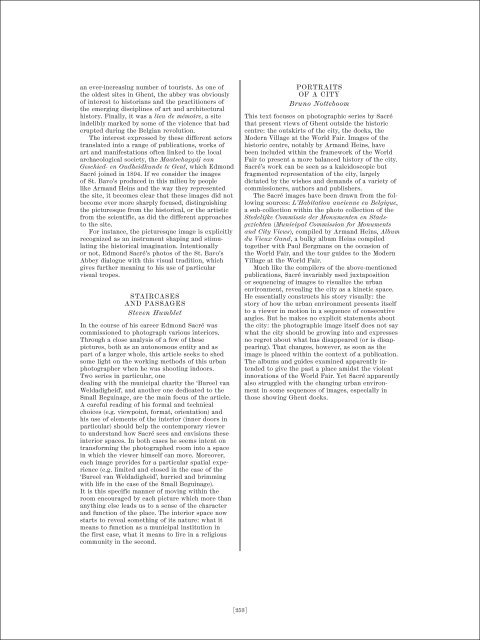Edmond Sacré Portret van een stad - Gent Cultuurstad vzw ...
Edmond Sacré Portret van een stad - Gent Cultuurstad vzw ...
Edmond Sacré Portret van een stad - Gent Cultuurstad vzw ...
You also want an ePaper? Increase the reach of your titles
YUMPU automatically turns print PDFs into web optimized ePapers that Google loves.
an ever-increasing number of tourists. As one of<br />
the oldest sites in Ghent, the abbey was obviously<br />
of interest to historians and the practitioners of<br />
the emerging disciplines of art and architectural<br />
history. Finally, it was a lieu de mémoire, a site<br />
indelibly marked by some of the violence that had<br />
erupted during the Belgian revolution.<br />
The interest expressed by these different actors<br />
translated into a range of publications, works of<br />
art and manifestations often linked to the local<br />
archaeological society, the Maatschappij <strong>van</strong><br />
Geschied- en Oudheidkunde te <strong>Gent</strong>, which <strong>Edmond</strong><br />
<strong>Sacré</strong> joined in 1894. If we consider the images<br />
of St. Bavo’s produced in this milieu by people<br />
like Armand Heins and the way they represented<br />
the site, it becomes clear that these images did not<br />
become ever more sharply focused, distinguishing<br />
the picturesque from the historical, or the artistic<br />
from the scientific, as did the different approaches<br />
to the site.<br />
For instance, the picturesque image is explicitly<br />
recognized as an instrument shaping and stimulating<br />
the historical imagination. Intentionally<br />
or not, <strong>Edmond</strong> <strong>Sacré</strong>’s photos of the St. Bavo’s<br />
Abbey dialogue with this visual tradition, which<br />
gives further meaning to his use of particular<br />
visual tropes.<br />
STAIRCASES<br />
AND PASSAGES<br />
Steven Humblet<br />
In the course of his career <strong>Edmond</strong> <strong>Sacré</strong> was<br />
commissioned to photograph various interiors.<br />
Through a close analysis of a few of these<br />
pictures, both as an autonomous entity and as<br />
part of a larger whole, this article seeks to shed<br />
some light on the working methods of this urban<br />
photographer when he was shooting indoors.<br />
Two series in particular, one<br />
dealing with the municipal charity the ‘Bureel <strong>van</strong><br />
Weldadigheid’, and another one dedicated to the<br />
Small Beguinage, are the main focus of the article.<br />
A careful reading of his formal and technical<br />
choices (e.g. viewpoint, format, orientation) and<br />
his use of elements of the interior (inner doors in<br />
particular) should help the contemporary viewer<br />
to understand how <strong>Sacré</strong> sees and envisions these<br />
interior spaces. In both cases he seems intent on<br />
transforming the photographed room into a space<br />
in which the viewer himself can move. Moreover,<br />
each image provides for a particular spatial experience<br />
(e.g. limited and closed in the case of the<br />
‘Bureel <strong>van</strong> Weldadigheid’, hurried and brimming<br />
with life in the case of the Small Beguinage).<br />
It is this specific manner of moving within the<br />
room encouraged by each picture which more than<br />
anything else leads us to a sense of the character<br />
and function of the place. The interior space now<br />
starts to reveal something of its nature: what it<br />
means to function as a municipal institution in<br />
the first case, what it means to live in a religious<br />
community in the second.<br />
[253]<br />
PORTRAITS<br />
OF A CITY<br />
Bruno Notteboom<br />
This text focuses on photographic series by <strong>Sacré</strong><br />
that present views of Ghent outside the historic<br />
centre: the outskirts of the city, the docks, the<br />
Modern Village at the World Fair. Images of the<br />
historic centre, notably by Armand Heins, have<br />
b<strong>een</strong> included within the framework of the World<br />
Fair to present a more balanced history of the city.<br />
<strong>Sacré</strong>’s work can be s<strong>een</strong> as a kaleidoscopic but<br />
fragmented representation of the city, largely<br />
dictated by the wishes and demands of a variety of<br />
commissioners, authors and publishers.<br />
The <strong>Sacré</strong> images have b<strong>een</strong> drawn from the following<br />
sources: L’Habitation ancienne en Belgique,<br />
a sub-collection within the photo collection of the<br />
Stedelijke Commissie der Monumenten en Stadsgezichten<br />
(Municipal Commission for Monuments<br />
and City Views), compiled by Armand Heins, Album<br />
du Vieux Gand, a bulky album Heins compiled<br />
together with Paul Bergmans on the occasion of<br />
the World Fair, and the tour guides to the Modern<br />
Village at the World Fair.<br />
Much like the compilers of the above-mentioned<br />
publications, <strong>Sacré</strong> invariably used juxtaposition<br />
or sequencing of images to visualize the urban<br />
environment, revealing the city as a kinetic space.<br />
He essentially constructs his story visually: the<br />
story of how the urban environment presents itself<br />
to a viewer in motion in a sequence of consecutive<br />
angles. But he makes no explicit statements about<br />
the city: the photographic image itself does not say<br />
what the city should be growing into and expresses<br />
no regret about what has disappeared (or is disappearing).<br />
That changes, however, as soon as the<br />
image is placed within the context of a publication.<br />
The albums and guides examined apparently intended<br />
to give the past a place amidst the violent<br />
innovations of the World Fair. Yet <strong>Sacré</strong> apparently<br />
also struggled with the changing urban environment<br />
in some sequences of images, especially in<br />
those showing Ghent docks.


